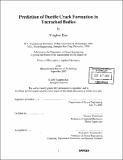Prediction of ductile crack formation in uncracked bodies
Author(s)
Bao, Yingbin, 1972-
DownloadFull printable version (22.44Mb)
Other Contributors
Massachusetts Institute of Technology. Dept. of Ocean Engineering.
Advisor
Tomasz Wierzbicki.
Terms of use
Metadata
Show full item recordAbstract
One of the important challenges facing the scientific and engineering community is the development of a reliable computational tool for predicting failure of structures under extreme and/or accidental loads. Considered in the present thesis is the process of formation of ductile cracks, which may be responsible for a catastrophic structural failure. Experimental, numerical and analytical studies are carried out on the prediction of ductile crack formation in uncracked bodies on an example of 2024-T351 aluminum alloy. A methodology for ductile crack formation suitable in industrial applications is developed through the introduction of different weighting functions for different stress triaxiality ranges where different ductile crack formation mechanisms occur ("shear fracture" in negative stress triaxialities, void nucleation, growth, and linkage in high stress triaxialities, a transition mode in intermediate stress triaxialities). A cut off value at the stress triaxiality of -1/3 is discovered. Effects of stress and strain ratios, specimen size and anisotropy are also quantified. It is found that the stress triaxiality and the equivalent strain are the two most important parameters governing ductile crack formation while other parameters are probably of secondary importance. A modification to the criterion is introduced to predict crack formation in a single reversal of straining. A case study of a solid aluminum 2024-T351 beam with a smooth round notch under 3-point bending is conducted. (cont.) Other cases of component validations on different materials, structures and loadings performed by colleagues in the Impact and Crashworthiness Lab are summarized. It is concluded that the proposed approach of predicting ductile crack formation holds a promise of becoming a reliable and practical calculation tool for industrial applications.
Description
Thesis (Ph. D.)--Massachusetts Institute of Technology, Dept. of Ocean Engineering, 2003. Includes bibliographical references (p. 233-247).
Date issued
2003Department
Massachusetts Institute of Technology. Department of Ocean EngineeringPublisher
Massachusetts Institute of Technology
Keywords
Ocean Engineering.